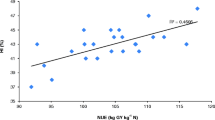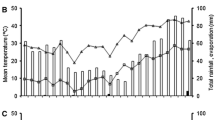Abstract
Nutrient efficiency in wheat is very complex. It includes two major types: nutrient acquisition efficiency and nutrient use efficiency. Various studies on wild, landraces, old, intermediate and new genotypes of cereals showed that the new varieties produced higher grain yields than the old varieties, and were also more efficient at using nutrients. Several spring wheat cultivars, representing almost all cultivars of spring wheat, released from the Federal Office for Cultivar Registration, Germany and published in the 'Descriptive List of Cultivars', were used to investigate the interactive effects between genotypes and the use efficiencies of the three macro nutrients N, P and K by the grain and straw. The results obtained in this study indicate that nutrient use efficiency of the single nutrients varies widely within recent cultivars. Some cultivars were identified as being multiple-nutrient use efficient. These are considered low-input cultivars. It appears that a special breeding programme of crop cultivars for low nutrient and stress conditions could be successful. Improved cultivar response to nutrients will help to reduce inputs and hence protect the environment.
Similar content being viewed by others
References
Altin, G.N. & K.J. Frey, 1990. Breeding crop varieties for low input agriculture. Am J Alt Agric 4: 53–58.
Austin, R.B., 1988. A different ideotype for each environment? In: M.L. Jorna & L.A.J. Slootmaker (Eds.), Cereal Breeding Related to Integrated Cereal Production. Proceedings of the EUCARPIA conference, pp. 47–60. PUDOC, Wageningen, the Netherlands.
Bingham, J.C. Law & T. Miller, 1991. Wheat yesterday, today and tomorrow. Plant Breeding International, Cambridge and Plant Science Research Ltd. 1–24.
Bundessortenamt, 1988. Beschreibende Sortenliste, Getreide, Mais, Ölfrü chte, Leguminosen. Verlag Alfred Strothe, Frankfurt/ M.
Bundessortenamt, 1993. Beschreibende Sortenliste fuer Getreide, Mais und Ölfrüchte 1993, pp. 18–44. Alfred Strothe Verlag, Hannover.
Dambroth, M. & N. El Bassam, 1990. Genotypic variation in plant productivity and consequences for breeding of low-input cultivars. In: N. El Bassam, M. Dambroth & B.C. Loughman (Eds.), International Symposium on Genetic Aspects of Plant Mineral Nutrition, pp. 1–7. Kluwer Academic Publishers, the Netherlands.
Damisch, W. & A. Wiberg, 1991. Biomass yield - A topical issue in modern wheat breeding programmes. Plant Breeding 107: 11–17.
El Bassam, N., 1989. Genotypic response of barley to nitrogen: A contribution towards characterisation and identification of low-input-genotypes. Science for Plant Breeding. XII. Eucarpia Congress, Vorträge für Pflanzenzüchtung 15: 23–30.
Fischbeck, G., 1988. Cereal breeding and input reductions in cultivars of cereals. In: M.L. Jorna & L.A.J. Slootmaker (Comps.), Cereal Breeding Related to Integrated Cereal Production. Proceedings of the EUCARPIA conference, pp. 9–27. PUDOC, Wageningen, the Netherlands.
Gardner, J.C., J.W. Maranville & E.T. Paparozzi, 1994. Nitrogen use efficiency among diverse sorghum cultivars. Crop Sci 34: 728–733.
Gerath, H. 1993. Entwicklung von Stickstoffeffizientem Winterraps. BML-Forschung, 9–11, Bonn.
Schinkel, B. & W. Mechelke, 1990. A method to estimate the prospect of specific breeding for nutrient efficiency In: N. El Bassam, M. Dambroth & B.C. Loughman (Eds.), International Symposium on Genetic Aspects of Plant Mineral Nutrition, pp. 449–456. Kluwer Academic Publishers, the Netherlands.
Spanakakis, A., 1990. Grain yield and quality characters of genotypes in F5 generation under low and high nitrogen input. In: N. El Bassam, M. Dambroth & B.C. Loughman (Eds.), International Symposium on Genetic Aspects of Plant Mineral Nutrition, pp. 456–464. Kluwer Academic Publishers, the Netherlands.
Strube, H. & A. Spanakakis, 1994. Zulassung von neuen Winterweizensorten; Stickstoffeffizienz. Mitteilung der Fr. Strube Saatzucht KG Sö llingen.
Viedt, A. & A. Spanakakis, 1989. Breeding wheat varieties with improved nitrogen utilisation I. Performance of winter wheat varieties under reduced nitrogen conditions. Vortäge für Pflanzenzü chtung 15: 23–28.
Author information
Authors and Affiliations
Rights and permissions
About this article
Cite this article
El Bassam, N. A concept of selection for 'low input' wheat varieties. Euphytica 100, 95–100 (1998). https://doi.org/10.1023/A:1018308023391
Issue Date:
DOI: https://doi.org/10.1023/A:1018308023391




